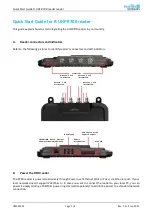
Rev 34.7/3-20
21
MR1611LDC: #35050
A
FTER
U
SING THE
L
IFTER
Leave the “attach/release” switch in the neutral position and place the power switch in the “off”
position ( ). The blue indicator light shuts off when the operator powers down the lifter.
CAUTION: Do not set the lifter against any surfaces which could soil or damage the
vacuum pads.
Built-in parking feet can be used to support an unloaded lifter that is not suspended from a
crane: Make sure the pad frame is oriented vertically with the parking feet at the bottom (see
OPERATING FEATURES orientation). Use the hoisting equipment to gently lower the lifter until
the parking feet support its entire weight. Make sure the lifter leans securely against an
appropriate support; then detach the hoisting equipment hook from the lift bail.
If the lifter is transported to another location, use the original shipping container and secure the
lifter, to protect the vacuum pads and all other components from damage while in transit.
Storing the Lifter
Use the covers supplied to keep the vacuum pads clean.
!!–CE–!! In accordance with CE Standard EN 13155, the lifter is designed to rest on relatively
horizontal surfaces without tipping over. To store the lifter in this way, set the lifter with the
pads facing downward on a clean, smooth, flat surface and place a support under the lift bail.
Since the lifter’s intended use does not include tilting, be careful to protect the vacuum pads and
support the lifter while tilting it to the horizontal position.
Charge the battery completely when placing it in storage and at 6-month intervals thereafter (see
MAINTENANCE: B
ATTERY
R
ECHARGE
). After charging the battery, disconnect the electrical
connectors uniting the battery to the battery charger and to the vacuum generating system, in
order to minimize power drainage. Preferred temperatures for storing the battery are 32° to 70°
Fahrenheit [0° to 21° Celsius]. Higher temperatures require the battery to be charged more
frequently. Storage at temperatures above 100° Fahrenheit [38° Celsius] should be avoided.
Summary of Contents for MR1611LDC
Page 2: ......
Page 38: ...Rev 34 7 3 20 36 MR1611LDC 35050 ...
Page 39: ...Rev 34 7 3 20 37 MR1611LDC 35050 ...
Page 40: ...Rev 34 7 3 20 38 MR1611LDC 35050 ...
Page 41: ...Rev 34 7 3 20 39 MR1611LDC 35050 ...
Page 42: ...Rev 34 7 3 20 40 MR1611LDC 35050 ...
Page 43: ...Rev 34 7 3 20 41 MR1611LDC 35050 ...
Page 44: ...Rev 34 7 3 20 42 MR1611LDC 35050 ...
















































